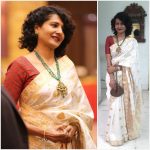Mahalaya…
61/100. Mahalaya. Signalling the start of Debi Pokhyo – the advent of the Goddess from heaven to earth. While the whole country gears up for the auspicious nine days of Navratri, the atmosphere in Bengal is of a different intensity altogether.
The sky is that autumn-blue, the clouds fluffy balls of cotton wool, the air fragrant with shiuli, and banks of lissome kaashphool rise up in any clear patch of green. Everywhere you look, Pujo pandals are being constructed. It is quite fascinating to see a Hogwarts or a Hobbit House under construction – no creative possibility is left unexplored. The billboards all have advertisements with women in the traditional red-bordered white sarees and big red bindis exhorting you to avail yourself of the latest ‘Pujo special’ offer.
And as you go about your daily business, it seems as if these billboard women have stepped off from their flex-and-canvas homes and are walking about all around you. Streets and offices alike are bright with women in their white-and-red. There is no Bengali woman worth her ‘issssh’ who will not wear her laal-pere(red bordered) saree at least once during this period. It’s almost as if there’s a primeval whisper in the air, urging us to don that red-and-white, symbolic of both purity and life, simplicity and grandeur, grace and power.
And in that red-and-white, there are some of us who look not just like the women of the ads, but the very Goddess we are getting ready to welcome. That typical Bengali face – round or oval, large-eyed and with masses of hair tumbling down – needs just a touch of kajal and a red bindi to look like a typical Durga idol. Many of us have grown up hearing this ultimate Bong compliment – ‘protima’r moton mukh’ – a face like a Durga idol. And to tell the truth, quite a few Bengali women have more of Durga in us than just her beautiful face.
Take Upasana. Bright and beautiful. With a face like Durga. And as feisty as they come. Straight and direct, she does not suffer meanness or pettiness gladly. Be it an action or a reaction, a word or an expression that is out of place, she will call it out. Regardless of consequences.
Durga Pujo, or for that matter any festival, is not only about acknowledging and thanking the past, it is also about celebrating the future. When I look at Upasana, I see a generation of women, separated from me and my contemporaries by just about 15 years but with a sureness and a certainty that I lack. The most marked difference is the lack of a need of approval, of validation from others. My friends and I – we have had to travel along the years to reach a point where it’s okay to be ‘me’. Upasana and her friends – they have never thought about not being themselves.
This Mahalaya, Upasana wore a white and red Sambalpuri silk that belongs to her grandmother. I wore a printed white cotton with a jute palla. And both of us, but of course, wore big red bindis.
There will be more saree stories with this young friend of mine. For today, it’s just a celebration of the Durga in the young women I admire every day. May their tribe increase. And this is also an acknowledgement of the little bit of Durga in the rest of us… May she rise more and find greater expression in us as well. As the invocation says, Jaago Durga…

